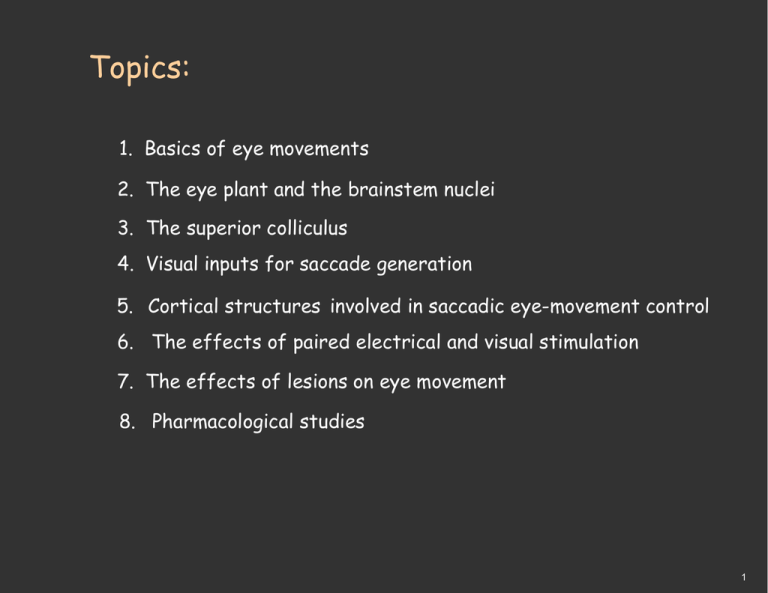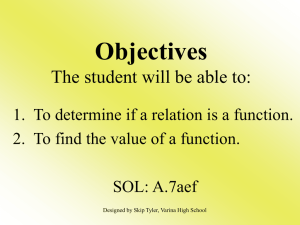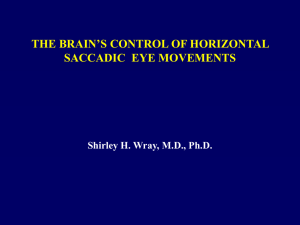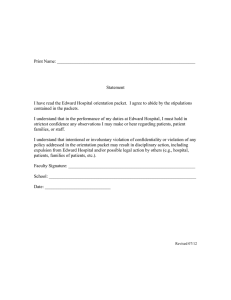Document 13367445
advertisement

Topics: 1. Basics of eye movements 2. The eye plant and the brainstem nuclei 3. The superior colliculus 4. Visual inputs for saccade generation 5. Cortical structures involved in saccadic eye-movement control 6. The effects of paired electrical and visual stimulation 7. The effects of lesions on eye movement 8. Pharmacological studies 1 5. Cortical areas involved in saccadic eye-movement control 2 Central Sulcus MEP MIP LIP STS FEF V1 Principalis Lunate Arcuate V4 Image by MIT OpenCourseWare. 3 superior colliculus medial eye fields frontal eye fields parietal cortex visual cortex MEF p FEF LIP SC ce sts V2 V1 ls BS 4 medial eye fields frontal eye fields parietal cortex superior colliculus ablated visual cortex MEF Anterior system p FEF LIP SC ce sts V2 V1 ls BS Posterior system 5 6. The effects of paired electrical and visual stimulation 6 The effect of paired electrical stimulation in the superior colliculus 1 and 2 1 or 2 1 2 1 1+2 SC ant post 2 lateral 1 2 medial 1 ant SC 2 1+2 post lateral 7 The effect of paired elecectrical stimulation in the left and right colliculi 1 posterior 2 SC anterior 1 2 1 or 2 1+2 1 and 2 8 Eye movements made to paired targets The task The eye movements elicited Image by MIT OpenCourseWare. 9 7. The effect of lesions on eye-movement control 10 Informal testing, intact monkey ce p ip sts ls 11 Informal testing after superior colliculus ablation ce p sc ip sts ls 12 Single target task 13 Single target task 14 Number of Saccades Distribution of saccadic latencies in intact monkey Express saccades 120 Regular saccadess 100 80 60 40 20 50 100 150 200 Latency in Milliseconds Schiller, Peter H., and Edward J. Tehovnik. "Look and See: How the Brain Moves Your Eyes About." Progress in Brain Research 134 (2001): 127-42. Courtesy of Elsevier, Inc., http://www.sciencedirect.com. Used with permission. 15 Distribution of saccadic latencies ten weeks after left superior colliculus lesion Number of Saccades Leftward saccades Rightward saccades 40 Intact representation 40 Ablated representation 30 30 20 20 10 10 50 100 150 200 50 100 150 200 Latency in Milliseconds Schiller, Peter H., and Edward J. Tehovnik. "Look and See: How the Brain Moves Your Eyes About." Progress in Brain Research 134 (2001): 127-42. Courtesy of Elsevier, Inc., http://www.sciencedirect.com. Used with permission. 16 Informal testing after frontal eye field ablation ce p fef ip sts ls 17 Number of saccades Distribution of saccadic latencies after FEF and MEF lesions Paired MEF & FEF Lesion FEF Lesion 50 40 40 30 30 20 20 10 10 N = 407 50 100 150 200 N = 313 50 100 150 200 Time in milliseconds 18 Sequential task 19 Figure removed due to copyright restrictions. Please see lecture video or Figure 8 from Schiller, Peter H., and Edward J. Tehovnik. "Look and See: How the Brain Moves Your Eyes About." Progress in Brain Research 134 (2001): 127-42. 20 The effect of FEF and MEF lesions on executing sequential saccades Figure removed due to copyright restrictions. Please see lecture video or Figure 9 from Schiller, Peter H., and Edward J. Tehovnik. "Look and See: How the Brain Moves Your Eyes About." Progress in Brain Research 134 (2001): 127-42. 21 Paired target task, identical targets 22 Paired target task, identical targets 23 Eye movements made to paired targets presented with varied asynchronies Left 34ms before right Simultaneous Right 34ms before left Image by MIT OpenCourseWare. 24 Reprinted by permission from Macmillan Publishers Ltd: Nature Neuroscience. Source: Schiller, Peter H., and I-han Chou. "The Effects of Frontal Eye Field and Dorsomedial Frontal Cortex Lesions on Visually Guided Eye Movements." Nature Neuroscience 1, no. 3 (1998): 248-53. © 1998. 25 Percent saccades to left targets Saccades made to identical paired targets presented with varied asynchronies 100 90 80 70 60 50 40 30 20 LFEF lesion wk3 pre-op wk2 wk16 4yrs 10 0 220 200 180 160 140 120 100 80 Right target first 60 40 20 0 20 40 60 80 100 120 140 160 180 220 220 Left target first Onset asynchrony in milliseconds Schiller, Peter H., and Edward J. Tehovnik. "Look and See: How the Brain Moves Your Eyes About." Progress in Brain Research 134 (2001): 127-42. Courtesy of Elsevier, Inc., http://www.sciencedirect.com. Used with permission. 26 Percent saccades to left targets Saccades made to identical paired targets presented with varied asynchronies 100 90 80 70 60 50 40 30 20 10 0 LFEF lesion RMEF lesion wk3 wk2 wk16 wk16 wk2 4yrs pre-op 220 200 180 160 140 120 100 80 Right target first 60 40 20 0 20 40 60 80 100 120 140 160 180 220 220 Left target first Onset asynchrony in milliseconds Schiller, Peter H., and Edward J. Tehovnik. "Look and See: How the Brain Moves Your Eyes About." Progress in Brain Research 134 (2001): 127-42. Courtesy of Elsevier, Inc., http://www.sciencedirect.com. Used with permission. 27 Informal testing after bilateral superior colliculus and frontal eye field ablation fef p fef sc sc ip sts ls 28 Further examination of the effects of microstimulation on eye-movement generation 29 The effects of pairing electrical stimulation with visual stimulation in four cortical areas Figure removed due to copyright restrictions. Please see lecture video or Figure 13 from Schiller, Peter H., and Edward J. Tehovnik. "Look and See: How the Brain Moves Your Eyes About." Progress in Brain Research 134 (2001): 127-42. 30 Experimental procedure: Map RF 1 Electrically stimulate 2 Present target in RF 3 Stimulate with paired targets 4 Stimulation initiated 30ms after target appearance for 80ms at 200H 31 Percent saccades to target in RF Percent of time target in RF is chosen, no stimulation stimulation 90 100 90 80 70 60 180 FRF 270 50 40 0 INTERFERENCE FACILITATION 30 20 10 0 -30 -20 -10 0 10 20 30 Temporal asynchrony (ms) relative to target in receptive field Schiller, Peter H., and Edward J. Tehovnik. "Look and See: How the Brain Moves Your Eyes About." Progress in Brain Research 134 (2001): 127-42. Courtesy of Elsevier, Inc., http://www.sciencedirect.com. Used with permission. 32 Stimulation added on selected trials Percent Saccades to Target in RF V1 100 90 80 70 Lower layers ON I AT T LI I C A F 10uA, 0% 60 50 7.5uA, 0% 40 30 RF 20 No Stimulation 10 0 -40 -30 -20 -10 0 10 20 30 40 50 60 70 80 90 100 Temporal asynchrony (ms) relative to target in receptive field Schiller, Peter H., and Edward J. Tehovnik. "Look and See: How the Brain Moves Your Eyes About." Progress in Brain Research 134 (2001): 127-42. Courtesy of Elsevier, Inc., http://www.sciencedirect.com. Used with permission. 33 Stimulation added on selected trials V1 Percent saccades to target in RF 100 Upper layers 90 90 80 E C No stimulation EN R E F ER T 30uA, 5% IN 70 0 180 60 RF 50 40 270 30 20 10 50uA, 10% 0 -20 -10 0 10 20 30 40 50 Temporal asynchrony (ms) relative to target in receptive field Schiller, Peter H., and Edward J. Tehovnik. "Look and See: How the Brain Moves Your Eyes About." Progress in Brain Research 134 (2001): 127-42. Courtesy of Elsevier, Inc., http://www.sciencedirect.com. Used with permission. 34 Stimulation added on selected trials Figure removed due to copyright restrictions. Please see lecture video or Figure 15B from Schiller, Peter H., and Edward J. Tehovnik. "Look and See: How the Brain Moves Your Eyes About." Progress in Brain Research 134 (2001): 127-42. 35 Stimulation added on selected trials Figure removed due to copyright restrictions. Please see lecture video or Figure 15A from Schiller, Peter H., and Edward J. Tehovnik. "Look and See: How the Brain Moves Your Eyes About." Progress in Brain Research 134 (2001): 127-42. 36 Saccadic latencies in LIP with increasing current levels Figure removed due to copyright restrictions. Please see lecture video or Figure 16 from Schiller, Peter H., and Edward J. Tehovnik. "Look and See: How the Brain Moves Your Eyes About." Progress in Brain Research 134 (2001): 127-42. 37 Stimulation added on selected trials FEF Percent saccades to target in MF 100 FACILITATION 90 80 25u,A, 45% 70 13uA, 0% 7uA, 0% 60 50 40 30 MF 20 No Stimulation 10 0 80 70 60 50 40 30 20 10 0 -10 -20 -30 Temporal asynchrony (ms) relative to target in motor field 38 Stimulation added on selected trials MEF Percent saccades to target in RF 100 90 FACILITATION 50uA, 65% 80 70 38uA, 5% 60 50 40 30 25uA, 0% No Stimulation 20 TZ 10 0 -30 -20 -10 0 10 20 30 Temporal asynchrony (ms) relative to target in terminal zone 39 medial eye fields MEF p ce sts ls 40 MEF One target in motor field Fixation spot in motor field Stimulation facilitates Stimulation prolongs fixation time 1 no stimulation 2 stimulation target onset 1 second 41 Summary of the effects of electrical stimulation: FACILITATION INTERFERENCE FIX INCREASE NO EFFECT V1 & V2, upper V1 & V2, lower V4 LIP FEF MEF 42 8. Pharmacological studies 43 Pharmacological manipulation electrodes for recording, stimulation and injection ce p FEF SC LIP ip sts ls V1 44 Bicuculline: a GABA antagonist. Therefore when infused inhibition is decreased Muscimol: a GABA agonist. Therefore when infused inhibition is increased 45 Effects of stimulation and injection in the superior colliculus stimulation/injection electrode medial anterior Electrical stimulation stimulation elicited saccades Muscimol injection inhibition of saccades with vectors represented at injected site Bicuculline injection spontaneous saccades with vectors represented at injected site Hikosaka and Wurtz 46 To assess the role of inhibitory circuits in cortex two behavioral tasks were used: 1. Paired target task 2. Visual discrimination task (oddity) 47 Percent saccades to target in RF Paired target task 90 100 90 80 70 60 0 180 FRF 270 50 40 INTERFERENCE FACILITATION 30 20 10 0 -30 -20 -10 0 10 20 30 Temporal asynchrony (ms) relative to target in receptive field 48 The oddity task 49 The oddity task 50 The effects of muscimol injection in cortex 51 Muscimol injection in V1, paired target task Figure removed due to copyright restrictions. Please see lecture video or the top panel of Figure 2 from Schiller, Peter H., and Edward J. Tehovnik. "Cortical Inhibitory Circuits in Eye‐movement Generation." European Journal of Neuroscience 18, no. 11 (2003): 3127-33. 52 Muscimol injection in FEF, paired target task Figure removed due to copyright restrictions. Please see lecture video or the middle panel of Figure 2 from Schiller, Peter H., and Edward J. Tehovnik. " Cortical Inhibitory Circuits in Eye‐movement Generation." European Journal of Neuroscience 18, no. 11 (2003): 3127-33. 53 Muscimol injection in LIP, paired target task Figure removed due to copyright restrictions. Please see lecture video or the bottom panel of Figure 2 from Schiller, Peter H., and Edward J. Tehovnik. "Cortical Inhibitory Circuits in Eye‐movement Generation." European Journal of Neuroscience 18, no. 11 (2003): 3127-33. 54 Muscimol injection, oddities task Figure removed due to copyright restrictions. Please see lecture video or Figure 3 from Schiller, Peter H., and Edward J. Tehovnik. "Cortical Inhibitory Circuits in Eye‐movement Generation." European Journal of Neuroscience 18, no. 11 (2003): 3127-33. 55 The effects of bicuculline injection in cortex 56 Bicuculline injection in V1, paired target task Image removed due to copyright restrictions. Please see lecture video or the top panel of Figure 4 from Schiller, Peter H., and Edward J. Tehovnik. "Cortical Inhibitory Circuits in Eye‐movement Generation." European Journal of Neuroscience 18, no. 11 (2003): 3127-33. 57 Bicuculline injection in FEF, paired target task Image removed due to copyright restrictions. Please see lecture video or the middle panel of Figure 4 from Schiller, Peter H., and Edward J. Tehovnik. "Cortical Inhibitory Circuits in Eye‐movement Generation." European Journal of Neuroscience 18, no. 11 (2003): 3127-33. 58 The effect of local bicuculline injection in the FEF on eye movements made to three targets Figure removed due to copyright restrictions. Please see lecture video or middle panel of Figure 7 from Schiller, Peter H., and Edward J. Tehovnik. "Neural Mechanisms Underlying Target Selection with Saccadic Eye Movements." Progress in Brain Research 149 (2005): 157-71. 59 Bicuculline injection in LIP, paired target task Image removed due to copyright restrictions. Please see lecture video or the bottom panel of Figure 4 from Schiller, Peter H., and Edward J. Tehovnik. "Cortical Inhibitory Circuits in Eye‐movement Generation." European Journal of Neuroscience 18, no. 11 (2003): 3127-33. 60 Bicuculline injection, oddities task Figure removed due to copyright restrictions. Please see lecture video or Figure 5 from Schiller, Peter H., and Edward J. Tehovnik. "Cortical Inhibitory Circuits in Eye‐movement Generation." European Journal of Neuroscience 18, no. 11 (2003): 3127-33. 61 Summary of the effects of the GABA agonist muscimol and the GABA antagonist bicuculline Target selection muscimol V1 INTERFERENCE FEF INTERFERENCE LIP SC Visual discrimination muscimol bicuculline INTERFERENCE V1 bicuculline DEFICIT DEFICIT FACILITATION FEF MILD DEFICIT NO EFFECT NO EFFECT NO EFFECT LIP NO EFFECT NO EFFECT INTERFERENCE FACILITATION Hikosaka and Wurtz 62 Saccade to new location A 1. 2. 3. 4. 1 B V1, V2, V4, IT, LIP, etc. A 2 C what? What are the objects in the scene? Which object to look at? Which object not to look at? Where are the objects in space? 5. When to initiate the saccade? B V1, V2, LIP, FEF, MEF A which? Br ain 3 C B V1, V2, LIP ar ea s A which not? 4 C B inv olv ed V1, V2, FEF, SC A where? 5 C B A LIP when? C 63 Summary wiring diagrams 64 Midget V1 V2 Mixed ? ? Parasol w LGN P M Midget Parasol V4 MT Posterior system PARIETAL LOBE w SC ? BS TEMPORAL LOBE BG rate code BS ? FRONTAL LOBE FEF MEF SN vector code vector code place code Anterior system 65 Midget V1 Auditory V2 Mixed ? ? Parasol system w LGN Somatosensory P M V4 MT Posterior system Midget Parasol PARIETAL LOBE ? TEMPORAL LOBE system Olfactory system w SC BG rate code BS BS vector code FRONTAL LOBE FEF MEF SN system vector code place code Vergence system Accessory optic system Smooth pursuit Anterior system Vestibular system 66 Summary: 1. Two major cortical systems control visually guided saccadic eye movements: The anterior and the posterior. 2. The anterior system has direct access to the brainstem whereas the posterior system passes through the colliculus. 3. Inhibitory circuits, as from the substantia nigra and in the frontal eye fields, are essential for generating properly directed saccadic eye-movements. 4. Areas V1, V2, FEF, LIP and SC carry a vector code. MEF carries a place code. 5. Paired ablation of the FEF and SC eliminates visually guided saccadic eye movements. 6. The posterior system is essential for producing express saccades. 7. The FEF plays a central role in the planning of saccadic sequences and target selection. 8. The posterior system is important for object identification, for deciding where to look and where not to look. LIP in addition is important for deciding when to look. The FEF and MEF contribute to where to look. 9. The role of the medial eye fields remains a puzzle. It may be involved in hand-eye coordination, in establishing spatial relationships and in visuo-motor learning. 67 The end Thank you 68 MIT OpenCourseWare http://ocw.mit.edu 9.04 Sensory Systems Fall 2013 For information about citing these materials or our Terms of Use, visit: http://ocw.mit.edu/terms.






